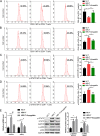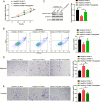Amygdalin promotes the activity of T cells to suppress the progression of HBV-related hepatocellular carcinoma via the JAK2/STAT3 signaling pathway
- PMID: 33435880
- PMCID: PMC7802162
- DOI: 10.1186/s12879-020-05713-0
Amygdalin promotes the activity of T cells to suppress the progression of HBV-related hepatocellular carcinoma via the JAK2/STAT3 signaling pathway
Abstract
Background: Hepatitis B virus (HBV) infection is a high-risk factor of hepatocellular carcinoma (HCC). Cellular immune responses are essential for HCC development, and the CD4+ and CD8+ T subtypes are identified as the primary anti-tumor immune cells. In the study, we investigated the effect and mechanism of amygdalin in the cellular immune response in HBV-related HCC and HCC progression.
Methods: The cell proliferation was examined by MTT analysis. Cells metastasis ability was detected by Invasion and migration assays. Quantification of apoptotic cells was performed with Flow cytometer assay. The protein levels of p-STAT3, STAT3, p-JAK2, JAK2, caspase-3, cleaved caspase-3 were detected by performing immunoblotting assays.
Results: We demonstrate that amygdalin treatment could rescue the HBV-T cell viability and IFN-γ and TNF-αproduction. In HBV-T cells, the MFI levels of CD8+ are lower than that in NC-T cells. Moreover, the phosphorylation levels of STAT3 and JAK2 are higher in HBV-T cells, compared to those in NC-T cells, and then reduced by amygdalin treatment. Co-culture with HBV-T cells could reduce IFN-γ and TNF-α, production while increase IL-6 and IL-10 production in HepG2.2.15 cells; these alterations could be partially reversed by amygdalin pretreatment. Finally, co-culture with HBV-T cells significantly promoted the cell viability, inhibited the apoptosis, and promoted the migration of HepG2.2.15 cells, and these alterations could be partially reversed by amygdalin treatment.
Conclusion: Our findings provide a rationale for further studies on the functions and mechanism of amygdalin inhibiting HBV-related HCC cell proliferation, invasion, and migration via T cell-mediated tumor immunity.
Keywords: Amygdalin; Hepatitis B virus (HBV); Hepatocellular carcinoma (HCC); T cell; The JAK2/STAT3 signaling.
Conflict of interest statement
The authors declare that they have no competing interests.
Figures




Similar articles
-
Small hepatitis B virus surface antigen promotes malignant progression of hepatocellular carcinoma via endoplasmic reticulum stress-induced FGF19/JAK2/STAT3 signaling.Cancer Lett. 2021 Feb 28;499:175-187. doi: 10.1016/j.canlet.2020.11.032. Epub 2020 Nov 27. Cancer Lett. 2021. PMID: 33249195
-
DTNA promotes HBV-induced hepatocellular carcinoma progression by activating STAT3 and regulating TGFβ1 and P53 signaling.Life Sci. 2020 Oct 1;258:118029. doi: 10.1016/j.lfs.2020.118029. Epub 2020 Jun 30. Life Sci. 2020. PMID: 32619495
-
IL-17 Activates the IL-6/STAT3 Signal Pathway in the Proliferation of Hepatitis B Virus-Related Hepatocellular Carcinoma.Cell Physiol Biochem. 2017;43(6):2379-2390. doi: 10.1159/000484390. Epub 2017 Oct 27. Cell Physiol Biochem. 2017. PMID: 29073625
-
Molecular mechanistic insight of hepatitis B virus mediated hepatocellular carcinoma.Microb Pathog. 2019 Mar;128:184-194. doi: 10.1016/j.micpath.2019.01.004. Epub 2019 Jan 3. Microb Pathog. 2019. PMID: 30611768 Review.
-
Tumor-associated macrophages and CD8+ T cells: dual players in the pathogenesis of HBV-related HCC.Front Immunol. 2024 Oct 10;15:1472430. doi: 10.3389/fimmu.2024.1472430. eCollection 2024. Front Immunol. 2024. PMID: 39450177 Free PMC article. Review.
Cited by
-
Xuanfei Baidu decoction in the treatment of coronavirus disease 2019 (COVID-19): Efficacy and potential mechanisms.Heliyon. 2023 Aug 19;9(9):e19163. doi: 10.1016/j.heliyon.2023.e19163. eCollection 2023 Sep. Heliyon. 2023. PMID: 37809901 Free PMC article. Review.
-
Apoptosis-promoting properties of miR-3074-5p in MC3T3-E1 cells under iron overload conditions.Cell Mol Biol Lett. 2021 Aug 16;26(1):37. doi: 10.1186/s11658-021-00281-w. Cell Mol Biol Lett. 2021. PMID: 34399682 Free PMC article.
-
Long noncoding RNA regulatory factor X3- antisense RNA 1 promotes non-small cell lung cancer via the microRNA-577/signal transducer and activator of transcription 3 axis.Bioengineered. 2022 Apr;13(4):10749-10764. doi: 10.1080/21655979.2022.2054910. Bioengineered. 2022. PMID: 35475457 Free PMC article.
-
Chinese medicine in the treatment of chronic hepatitis B: The mechanisms of signal pathway regulation.Heliyon. 2024 Oct 12;10(20):e39176. doi: 10.1016/j.heliyon.2024.e39176. eCollection 2024 Oct 30. Heliyon. 2024. PMID: 39640799 Free PMC article. Review.
-
Amygdalin as a Promising Anticancer Agent: Molecular Mechanisms and Future Perspectives for the Development of New Nanoformulations for Its Delivery.Int J Mol Sci. 2023 Sep 19;24(18):14270. doi: 10.3390/ijms241814270. Int J Mol Sci. 2023. PMID: 37762572 Free PMC article. Review.
References
-
- Llovet JM, Burroughs A, Bruix J. Hepatocellular carcinoma. Lancet. 2003;362(9399):1907–1917. - PubMed
-
- Bosch FX, et al. Primary liver cancer: worldwide incidence and trends. Gastroenterology. 2004;127(5 Suppl 1):S5–S16. - PubMed
-
- Hao XS, et al. Twenty-year trends of primary liver cancer incidence rates in an urban Chinese population. Eur J Cancer Prev. 2003;12(4):273–279. - PubMed
-
- Chen CJ, Iloeje UH, Yang HI. Long-term outcomes in hepatitis B: the REVEAL-HBV study. Clin Liver Dis. 2007;11(4):797–816. - PubMed
-
- Schmidt N, Neumann-Haefelin C, Thimme R. Cellular immune responses to hepatocellular carcinoma: lessons for immunotherapy. Dig Dis. 2012;30(5):483–491. - PubMed
MeSH terms
Substances
Grants and funding
LinkOut - more resources
Full Text Sources
Other Literature Sources
Medical
Research Materials
Miscellaneous

